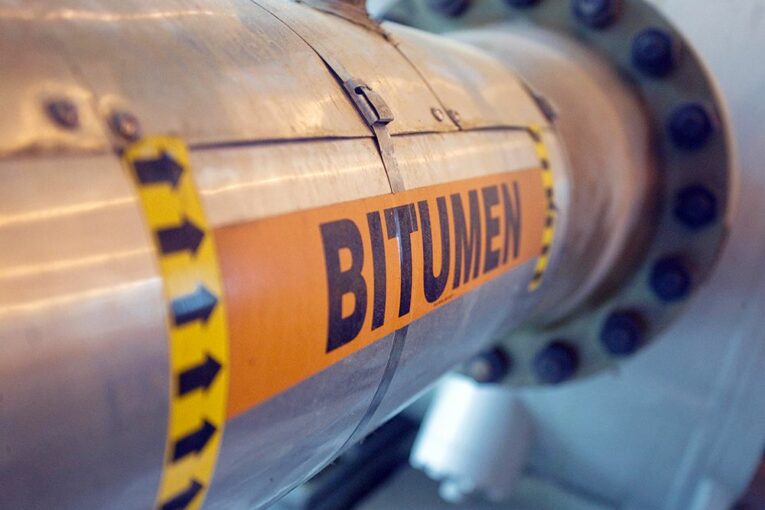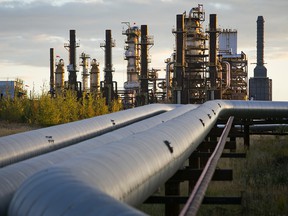
When the provincial budget was unveiled back in February, projecting a whopping $18-billion deficit, bitumen royalties were expected to be stunted, contributing only $1.5 billion to Alberta’s cash-strapped coffers.
No oilsands projects were projected to shift into a higher royalty tier from a lower rate this year, while natural gas royalties were forecast to add only $467 million to the overall revenue pot.
Suddenly, the outlook has changed like a chinook blowing into the province.
On Tuesday, the province’s mid-year fiscal update was released , featuring a revenue resurgence — up $14 billion since budget day.
It’s powered by higher energy prices and a bitumen bonanza, along with rising income tax revenues and improved investment returns.
Bitumen royalties are now expected to top $7.6 billion this year, an astounding 413 per cent increase from February’s budget.
Five oilsands projects will graduate this year into paying a higher royalty rate due to rising crude prices, which means they will spit out significantly more money into the treasury. Another project will move into post-payout mode next year.
Royalties from natural gas and associated liquids are now expected to hit $1.6 billion, its highest point since Ed Stelmach was premier.
Albertans rightfully want to diversify the economy and smooth out the severe turbulence created by volatile energy prices.
But here’s an inescapable truth: Oil and gas revenues continue to power a big portion of government revenues, playing a supersized role in the province’s finances, even in an era of industry consolidation and decarbonization.
-

Braid: Alberta’s sensational fiscal turnaround is welcome but could be fragile
-

Alberta’s projected deficit drops to $5.8 billion, buoyed largely by global energy price spike
As for this year’s expected budget deficit — surprise, surprise — it’s been whittled down to $5.8 billion, and it’s projected to drop to $2.3 billion by 2023-24.
“Let’s be clear, the improvement in the finances we’re seeing today has got relatively little to do with diversification and everything having to do with a higher payout from the oilsands industry and higher energy prices,” said economist Ron Kneebone with the University of Calgary’s School of Public Policy.
“This is still our meat and potatoes, and I don’t think there is anything wrong with that.”
With more oilsands projects paying a higher royalty rate, the shift should improve the predictability of Alberta’s resource revenues, said Finance Minister Travis Toews.
“When a project moves from pre- to post-payout, the non-renewable resource revenues from the province or royalties go up by a quantum of four-plus,” Toews said in an interview.
“We are really moving into a time where Albertans broadly will benefit from that great investment in Alberta’s oilsands.”
Under Alberta’s royalty system, oilsands developments initially pay a lower rate — between one and nine per cent of gross revenues — until a project’s total revenues exceed its total capital and operating costs.
At that point, the rate jumps to between 25 and 40 per cent of net revenues, depending on oil prices.
According to the province, 61 oilsands projects were in post-payout last year, reflecting total production of 1.9 million barrels per day (bpd). Five new developments shifting into post-payout will add about 400,000 bpd to the higher category.

Alberta’s bitumen bounty is paying off as new production records have been set this year. Output reached 3.84 million barrels per day in October, according to ATB Financial; 86 per cent of all crude production this year has come from the oilsands.
The fiscal update shows total resource revenue will top $10.9 billion this year, an $8-billion bump from last year’s anemic levels and its highest point since 2011-12.
“What we’re seeing here is exactly why oil and gas is so important to the province,” said Ben Brunnen, a vice-president with the Canadian Association of Petroleum Producers.
“Substantial revenues and prosperity can be realized as a result of this investment.”
The change also highlights the dizzying impact such revenue fluctuations can have on the province’s books. Resource revenue is projected to make up 19 per cent of all government revenues this budget year.
In 2020-21, it stood at 7.2 per cent.
“Oil and gas is our comparative advantage. This is what makes us wealthy,” said Kneebone.
“It’s not the economy we need to diversify. What we need to diversify is the government’s sources of revenues. And we’re heavily reliant on one source of revenue, which itself is very volatile.”
That’s for sure.
On Friday, news of the new Omicron COVID-19 variant rattled markets and knocked $10 off the price of benchmark U.S. oil. After a modest rebound to start this week, prices for West Texas Intermediate crude tumbled more than $3 to close at US$66.18 a barrel on Tuesday.
Coincidentally, the province just increased its oil price forecast in its second-quarter update to $70.50 a barrel.
“This is just a reminder, again, of the uncertainty and volatility in the global economy right now. A pandemic is still at play,” Toews added.
The natural gas outlook is improving, with Alberta prices expected to average $3.30 per gigajoule, up from $2.10 a year earlier.
Toews noted the oil industry is finally seeing more pipeline capacity out of the province with the opening of Enbridge’s Line 3 project. Drilling activity is picking up this winter and oilpatch capital investment is anticipated to increase by 26 per cent this year.
The provincial economy is expected to grow by 6.1 per cent in 2021, then expand by 5.1 per cent in 2022, allowing Alberta’s GDP to finally return to 2014 levels.
As the province’s fiscal update notes, “the recovery in business output this year is largely being driven by the energy sector,” although housing activity remains robust, retail sales are climbing and non-energy sector investments are poised to increase by seven per cent next year.
Almost all of Alberta’s revenue sources, including corporate and personal income taxes, are improving with the upturn, Toews noted.
But energy prices are still a key economic driver, and they’re bouncing around.
In this update, however, they’ve bounced in the right direction.
Chris Varcoe is a Calgary Herald columnist.
You can read more of the news on source
